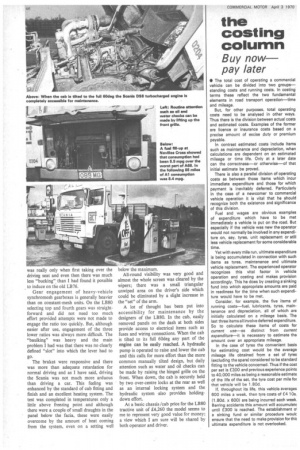the costing column
Page 48

If you've noticed an error in this article please click here to report it so we can fix it.
Buy now pay later
• The total cost of operating a commercial vehicle can be divided into two groups— standing costs and running costs. In costing terms these reflect the two fundamental elements in road transport operation—time and mileage.
But, for other purposes, total operating costs need to be analysed in other ways. Thus there is the division between actual costs and estimated costs. Examples of the former are licence or insurance costs based on a precise amount of excise duty or premium payable.
In contrast estimated costs include items such as maintenance and depreciation, when calculations are dependent on an estimated mileage or time life. Only at a later date can the correctness—or otherwise—of that initial estimate be proved, There is also a parallel division of operating costs as between those items which incur immediate expenditure and those for which payment is inevitably deferred. Particularly in the case of a newcomer to commercial vehicle operation it is vital that he should recognize both the existence and significance of this division.
Fuel and wages are obvious examples of expenditure which have to be met immediately a vehicle is put on the road. But especially if the vehicle was new the operator would not normally be involved in any expenditure on, say, tyres, unit replacement or still less vehicle replacement for some considerable time.
Yet with every mile run, ultimate expenditure is being accumulated in connection with such items as tyres, maintenance and ultimate vehicle replacement. The experienced operator recognizes this vital factor in vehicle operation and costing and makes provision accordingly. This he does by creating a sinking fund into which appropriate amounts are paid in readiness for the time when such expenditure would have to be met.
Consider, for example, the five items of running costs—fuel, lubricants, tyres, maintenance and depreciation, all of which are initially calculated on a mileage basis. The last three items all involve deferred expenditure. So to calculate these items of costs for current use—as distinct from current expenditure—it is necessary to estimate the amount over an appropriate mileage.
In the case of tyres the convenient basis for estimating cost would be the average mileage life obtained from a set of tyres (excluding the spare) considered to be standard fitting to the vehicle concerned. Thus if the cost per set is £300 and previous experience points to 40,000 miles as being a reasonable estimate of the life of the set, the tyre cost per mile fat that vehicle will be 1.80d.
If, throughout its life, this vehicle averages 600 miles a week, then tyre costs of E4 10s. (1.80d. x 600) are being incurred each week Barring accidents this amount will accumulatf until £300 is reached. The establishment o' a sinking fund or similar procedure woulc ensure that the need to make provision for this ultimate expenditure is not overlooked.








































































































